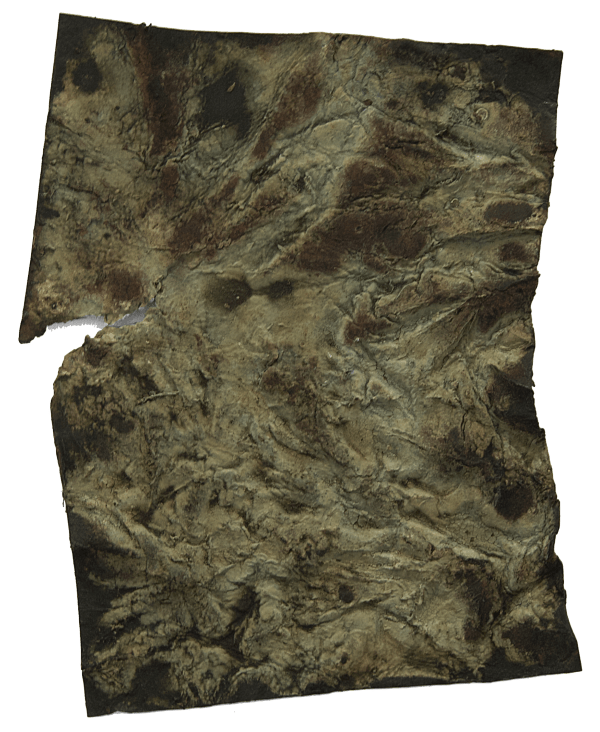-
Marcia Kure: Reticulation
-
Susan Inglett Gallery is pleased to present MARCIA KURE: Reticulation, on view from 6 September 2022 through 15 October 2022.
Following her site-specific installation NETWORK, on view through 22 September at the Menil Drawing Institute, and her commission The Amina Project for the group exhibition PROCESS at Alexander McQueen London, Marcia Kure continues to explore the complex histories of trade and migration through sculpture, drawing, and collage.
-

-
Reticulation investigates our shared responsibility in perpetuating networks of exchange. Focusing on gestural lines, Kure employs marks as a means of illuminating the contemporary resonance of systems indebted to colonial histories. Through her signature use of canvas and paper soaked in natural pigments-indigo and kola nut- the artist physically imbues her work with the commodities that were once a mainstay of transatlantic commerce.
Kure considers the histories of her chosen mediums as implicated in colonial networks of exchange. Indigo, for example, reveals the cross-cultural movement between Europe, India, and the Americas. Europeans were first introduced to indigo through trade with India. Wanting a cheaper source of the opulent commodity, European settlers began cultivating the crop in North America. As indigo extraction is a particularly labor-intensive process, the import of enslaved Africans escalated in the southern colonies as a result of the indigo boom of the mid-18th century. By using indigo, the artist activates the material’s fraught history, emphasizing the movement of goods and bodies that took place to cultivate the crop– and subsequently to create her work.
-
In addition to indigo, Kure uses pigment derived from kola nut as a central element in the creation of works that speak to historic systems of exchange. Grown from the kola tree, this seed holds prominence in West African societies as a symbol of friendship and respect. It is utilized in coming-of-age rituals, infant naming ceremonies, funerals, and other cultural and community-centered events. The caffeine-rich kola nut also has medicinal properties. It is chewed to counteract fatigue and alleviate thirst and hunger. Kure extracts from the kola nut a pigment with deep orange hues and warm tones of sienna and ochre for use in some of her drawings. Here, the artist brings to life the symbolism of the kola nut, creating works imbued with Nigerian traditions of hospitality and exchange.
-
 MARCIA KURE, RETICULATION, 2022
MARCIA KURE, RETICULATION, 2022 -
Through abstraction, Kure asks how histories of movement and migration can be translated into a singular line. Her works on canvas and paper reference the curvilinear shape of the Uli line, a Nigerian design motif traditionally drawn on bodies. Building on her site-specific installation at the Menil, the third of an ongoing series of wall drawings, this work collapses time and space to fuse systems of power and control into one mark. By treating the paper or canvas as skin, these marks become a site of remembrance, holding within them histories of colonization and exploitation.
-
Drawing has been a life-long journey. It’s been a language that I’ve been trying to understand for the longest time—from historic South African cave drawings, to collage, to sewing—trying to find my own way of drawing the line. Line is not a mere mark on paper, it’s something that contains memory, purpose, and thought. Line is something that we all engage with daily, our entire body participates in making the mark, implicating us all in a vast interconnected and entangled network that continues beyond the wall.
-Marcia Kure
-
Employing the same labor-intensive techniques of soaking and staining, a series of grid paintings on paper manifests as the physical embodiment of time and underscores the artist’s relationship with nature, yet another system of exchange. In a painstaking process, Kure invites the labor of seasons and the passage of time to partake in the creation of her works; dotted planes and geometric patterns trace the outcome of this collaboration. Kure titled her grid works in Bamum (or Shümom), an indigenous African writing system of the Cameroon Grassfields. Invented by King Ibrahim Njoya in 1896, Bamum was a syllabic script used for administrative purposes, documentation, and education. As a result of colonial suppression in the 1930s, it has largely fallen into disuse. These titles provide an additional layer to the work, considering the ways that not only line, but language represents an ever-connected system of power.
-
-
 MARCIA KURE, Abstract Bodies: ¤, 2022
MARCIA KURE, Abstract Bodies: ¤, 2022 -
 MARCIA KURE, Abstract Bodies: μ, 2022
MARCIA KURE, Abstract Bodies: μ, 2022 -
 MARCIA KURE, Abstract Bodies: ꛦ, 2022
MARCIA KURE, Abstract Bodies: ꛦ, 2022 -
 MARCIA KURE, Abstract Bodies: ꛴, 2022
MARCIA KURE, Abstract Bodies: ꛴, 2022
-
-
In her ongoing collage series, the artist combines source material from her studio, in this case culling images from Oprah Winfrey’s book, Journey to the Beloved, snippets of beauty and fashion magazines, and pages from the archives of the Ethnographical Museum in Stockholm. Kure evokes the work of early Dadaist photomontage, utilizing mass-produced imagery and ethnographic renderings to create her works.
-
I came to collage via drawing. When trying to solve a drawing problem, I realized I could cut the shapes around a form or figure, combining them to create new interactions and narratives, dis/unity, tension and friction. Line is activated where the cut and the image meet. For me, the emphasis has always been on line - and the images the cut shapes contain.
- Marcia Kure
-
Through collage, Kure reassembles body parts to create figures where histories of colonial subjugation and standards of beauty collide.
-
 MARCIA KURE, WHIRLWIND, 2022
MARCIA KURE, WHIRLWIND, 2022 -
Throughout the exhibition, Marcia Kure links her deliberately chosen mediums and materials: indigo, kola nut, charcoal, ink on canvas, collage, paper, and wood under the central theme of the line. In doing so, she reminds us that we too are elements of the line, existing in an ever-connected network of exchange.
-
-

MARCIA KURE: Reticulation
Past viewing_room


















